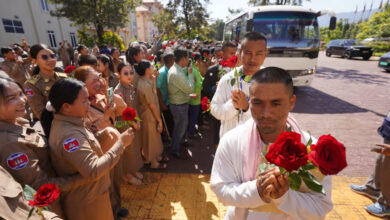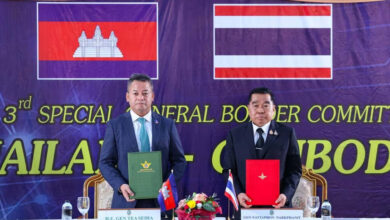
North Korea fired several suspected cruise missiles Tuesday towards the sea, according to the South’s military, with analysts saying Pyongyang was demonstrating the breadth of its arsenal.
The “multiple projectiles” fired from Munchon in the east of the country were believed to be “short-range cruise missiles”, the Joint Chiefs of Staff said in a statement.
The test comes a day before the South holds parliamentary elections, and at a time when the world’s attention has been largely focused on the coronavirus pandemic, which Pyongyang insists it has so far escaped.
It also comes the day before the nuclear-armed North marks the 108th anniversary of the birth of founder Kim Il Sung, grandfather of the current leader Kim Jong Un.
In recent years Pyongyang has repeatedly tested ballistic missiles, which are propelled high above the Earth — often into space — before descending towards their targets at high speed by the force of gravity.
The North’s arsenal includes intercontinental ballistic missiles (ICBMs) capable of reaching the entire US mainland.
In contrast, cruise missiles travel at low altitudes — sometimes just a few meters (feet) above the surface, making them hard to detect — and are powered throughout their flight.
Frequently highly maneuverable, they need sophisticated guidance systems to bring them to their targets.
Tuesday’s missiles traveled over the Sea of Japan, also known as the East Sea, before coming down in the water, the JCS said.
The North also flew multiple Sukhoi-variant and MiG fighter jets above the eastern coastal city of Wonsan, which fired multiple air-to-ground rockets, a spokesman added.
“South Korea and US intelligence authorities are closely analyzing related issues,” the statement said.
Pyongyang was demonstrating that it had “various options” when it came to weapons delivery systems, said Cha Du-Hyeogn, senior researcher at the Asan Institute for Policy Studies.
“Ballistic missiles demonstrate destructive power while cruise missiles show accuracy,” he told AFP.
“Until now North Korea has shown its force, and now it is demonstrating accuracy in striking targets.”
– ‘Treading carefully’ –
The North is subject to multiple UN Security Council sanctions over its banned weapons programmes.
It has carried out a series of weapons tests in recent months — often describing them as multiple launch rocket systems, while others have called them ballistic missiles.
It has also fired cruise missiles in the past, as in June 2017 when it hailed the successful test of what it called a new type of surface-to-ship cruise missile.
Those missiles flew around 200 kilometres (125 miles) and were launched the week after two US aircraft carriers took part in naval manoeuvres in the Sea of Japan.
North Korean leader Kim Jong Un and US President Donald Trump traded mutual insults and threats of war during 2017, sending tensions soaring.
The South’s President Moon Jae-in used the Pyeongchang Winter Olympics in his country to broker a diplomatic rapprochement and a series of summits followed.
But talks between Pyongyang and Washington have been largely deadlocked since their Hanoi summit broke up in February last year amid disagreement on sanctions relief and what the North would be willing to give up in return.
Tuesday’s missiles traveled around 150 kilometers (96 miles) according to Seoul, and Go Myong-hyun — an analyst at the Asan Institute for Policy Studies — said the short range was likely to have been deliberately chosen by Pyongyang.
“North Korea is still deciding what kind of strategic position it should take between provocation and dialogue,” he told AFP.
“It is treading carefully. It is firing missiles to raise tensions, but the level of tension is not that high.
“At this point, I wouldn’t be surprised if North Korea carries out more provocations, or if it suddenly says it is ready to talk.”
Image: KCNA VIA KNS/AFP/File / STR The latest test comes a day before North Korea marks the 108th anniversary of the birth of founder Kim Il Sung, grandfather of current leader Kim Jong Un




